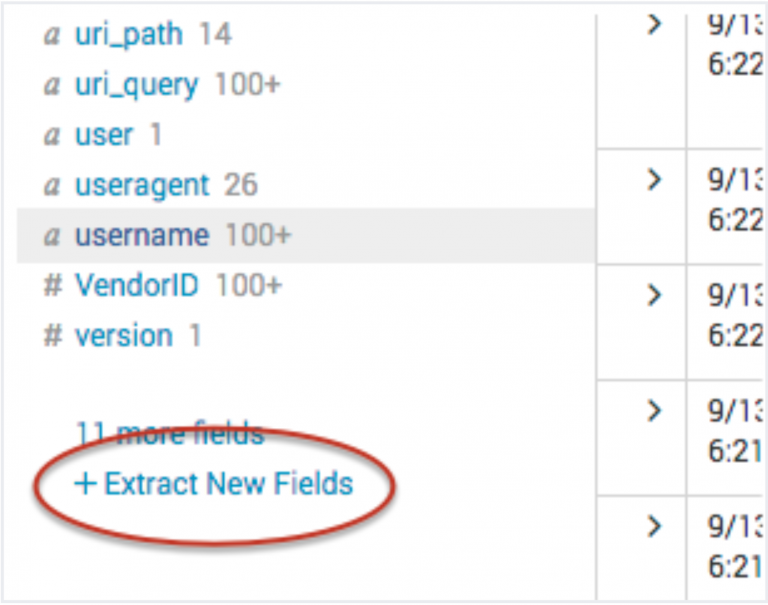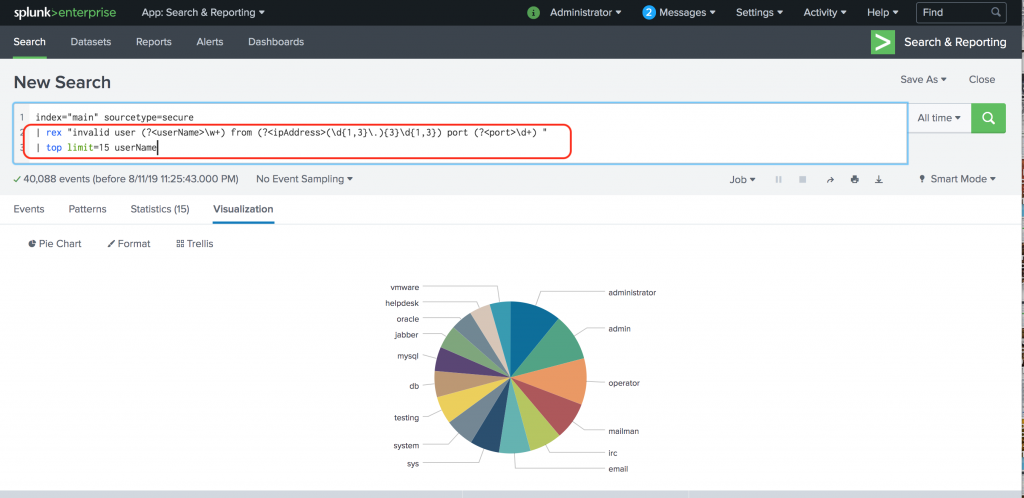

This splits the error message into fields faileduserid, failedfromIP and failedport. The following shows an example of a user authentication failure The command rex can be used against the raw data (using _raw or excluding any field), alternatively if your logs are large, then you could target the rex against a particular field within the log, which would aid performance using “ rex field=“.Įxample Search for User Authentication Failure This can then be used to search on, for example adding | where faileduserid = “appserver”
#Splunk rex field raw example password#
This targets the highlighted string in the log entry for a failed password “ Failed password for invalid user appserver from 194.8.74.23 port 3351 ssh2“.

The above shows how a simple regex “ invalid\suser\s(? \w+)\s” is included into the splunk search query, this regex selects a word of any length, after the string “invalid user ” and before the next space and the output is placed inside field “ faileduserid“ The assignment of a result field for the output of the regex, is done via the splunk command rex, a example of the syntax is below: Rex “ rex is a SPL (Search Processing Language) command that extracts fields from the raw data based on the pattern specified using regular expressions (or regex)” So you have some basic knowledge of REGEX, now you want to use it…one of the ways in which splunk uses regex, allows the result of the regex to be stored in a field, which can then be used in other parts of the search and also in the output (I prefer this method, no reason, I just do). Matches words ending with “is”, because it’s followed by a boundary Matches “is” as a whole word, because it’s preceded and followed by a boundary Matches any 7 letter word, followed by a word boundary (non-alphanumeric) Matches any non-empty word (essentially any sequence of alphanumeric chars) Matches word “ abc” NOT followed by boundary, so “ abcd“, but not “ abc,“ Matches word “ abc” followed by boundary, so “ abc,” but not “ abcd“ Match all text between quotes, so “ abc” returns abc, as such removes the quotes Match a non-empty string, which does not contain a‘s, b‘s or c‘s Match a non-empty string, containing a‘s, b‘s or c‘s

Match an “ a“, followed by any character, followed by a “ c“Įxact match an “ a“, followed by a “. Match an “ a“, followed by 2,3 or 4 x “ b“, followed by a “ c“ Match an “ a“, followed by at least 2 x “ b“, followed by a “ c“

Match either “ abc” at the start or “ xyz” at the end of the search stringĮxact match an “ a“, followed by exactly 2 x “ b“, followed by a “ c“ Match either “ a“, “ b” or “ c” anywhere in the search string The following samples show how some of the basic REGEXs work, to show how these elements all work together to execute the search based on the matching pattern.Įxact match “ abc” anywhere in the search stringĮxact match “ abc” at the start of the search stringĮxact match “ xyz” at the end of the search string This is not an in depth regex tutorial, its a basic overview of some the searches available and how they integrate into splunk. key=value, so something like username=xxx is fine, but something like password wrong for user xxx would not work, at this point step in regex and take a bow…Ī REGEX contains some basic elements (shown below), which all work together to specify the search pattern. Regular Expressions can be simply thought of “wildcards on steroids” as they allow very deep and specific pattern matching.ĭo you need to learn or use regex within splunk, well for basic searches the answer is “NO”, also by default splunk does a good job of automatically extracting interesting fields (using its inbuilt regex extractor IFX “Interactive Field Extractor”), and displays them on the left of the search panel, but this only works if splunk can recognise the interesting field using a key/value pair, e.g.
#Splunk rex field raw example series#
A Regular Expression or REGEX is a way of specifying a series of characters used in a search pattern these patterns are used to find/match a pattern within a data set and return the matched results.


 0 kommentar(er)
0 kommentar(er)
